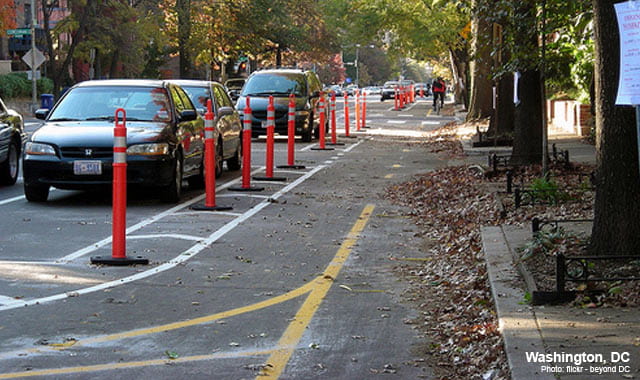A recent IIHS study comparing protected bike lanes with other forms of bike infrastructure found an unexpected result: That 2-way, street-level protected bike lanes, also called cycle tracks, carried 11.4 times greater risk of injury than riding in the street on a busy road (the reference condition).
The safety of bike infra is important, and so a study like this is welcome. Design details matter, and it’s possible that a well-intentioned design could have unexpected negative consequences. So, what should one make of this finding that two-way, street-level cycle tracks are relatively dangerous?
First, consider another finding of this study: Of all bike infra types other than off-road trails, two-way cycle tracks, both street-level and raised, showed the lowest risk of injury stemming from a collision with a motor vehicle. The study looked at any injury that took a person to an emergency room, and it turns out that only 40% of them involved a collision with a moving vehicle. Many injuries were due to falls, hitting a stationary obstacle, and so forth; that’s why the title of the report refers to “collisions and falls leading to emergency room visits”. Not coincidentally, only 42% of the injuries were classified by hospital personnel as moderate or severe; 58% were classified as minor, or so mild they were deemed no injury. This prevalence of falls and minor injuries is well known from other bicycling injury studies.
When looking only at injuries stemming from a collision with a moving vehicle (see the report’s Table 6), it turns out that two-way protected bike lanes, both those at street level and those that are raised, were found to have a relative risk of 0.73, lower than every other infra type other than off-street trails. By comparison, riding in mixed traffic on a busy road has a relative risk of 1.00 and conventional bike lanes on a busy road have a relative risk = 1.10. The sample size isn’t large enough to call these differences statistically significant, but for the sample size available, they represent the best estimate of how risk varies by infra type.
Among the hazards of riding a bike, being hit by a motor vehicle is the one people worry most about, and rightfully so, because it’s the hazard most likely to cause serious or fatal injury. I don’t know many people who won’t ride a bike out of fear they might fall or hit a tree or a pedestrian, but I know a lot who won’t ride because they fear a collision with a car or truck. So, where it counts the most, these protected bike lanes were actually found to be the safest. One-way cycle tracks were estimated to have the next lowest injury risk.
Second, a careful look at the report reveals that for on-street two-way cycle tracks, with injuries from falls and all other causes included, a 5-block section of Washington’s 15th Street cycle track is a clear outlier that should have been analyzed separately. The authors tried to make the study robust by interviewing a lot of victims in 3 cities, but for two-way cycle tracks at street level, they had only 21 injury victims, and it turns out that 10 of them came from the short section of cycle track along 15th Street between Massachusetts Avenue and H Street, where 15th Street is two-way (Table 7). Remove that stretch, and – considering all injuries – two-way cycle tracks have a relative risk of about 1. Good analysis would recognize that outlier and offer different conclusions for that particular stretch (it has high general injury risk) and for two-way cycle tracks as a general infra type (they carry about the same injury risk as the base condition).
What’s special about that 5-block stretch? It’s in the heart of Washington’s commercial downtown, with very high volumes of crossing pedestrians and heavily used parking lot driveways. In this environment, it’s easy to see how sudden, unexpected movements across the cycle track might lead to falls, collisions with pedestrians or other bikes, and minor-injury crashes with stopped vehicles.
The 15th St cycle track has a much longer stretch north of Massachusetts Avenue, where 15th Street is one-way (though the cycle track is still 2-way). This stretch showed no unusual injury risk (3 injuries versus 4 controls; “average risk” would be an equal number of cases and controls). Interestingly, this stretch has about twice as many driveways/alleys per mile and twice as many intersections per mile as the downtown stretch, but they lack the intensity of use seen in downtown. The contrast between these two stretches shows why it would be misleading to conclude that two-way, street-level cycle tracks are generally risky.
Third, it would be wrong to read much into the particular estimate of relative risk reported for in-street, two-way cycle tracks, which is 11.4. The reported confidence interval is [1.40 to 92.6], which is like saying, “We’re pretty sure the relative risk is more than 1, but beyond that it could be anything.” The huge confidence interval is due to the low number of victims and controls using two-way cycle tracks, and, as stated earlier, the relative risk is greater than 1 only because of including injuries not involving a moving vehicle.
In conclusion, the IIHS report supports the common-sense notion that separated bike lanes, both one-way and two-way, both street-level and raised, reduce risk of injury stemming from a collision with motor vehicles. It shows that when injuries from falls and non-vehicle collisions are included, some stretches of two-way cycle track can carry higher than usual injury risk, and therefore deserve targeted attention. The conclusion that some are drawing from a superficial reading of the report, that two-way cycle tracks are dangerous and should be avoided, is a gross misreading of the data.
2019 / October 8
